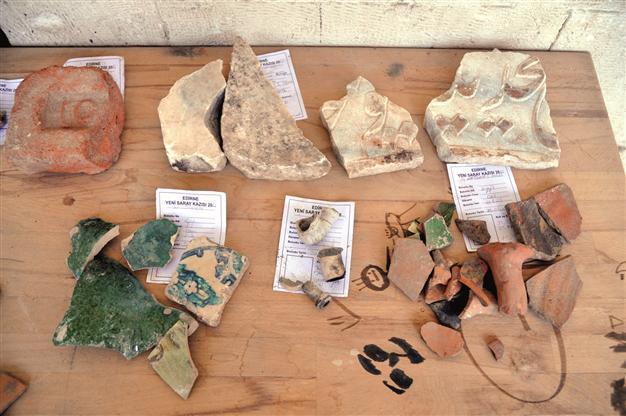Edirne Palace restorations reveal Ottoman era culture
ISTANBUL - Anadolu Agency

The findings were cleaned at the excavation sites in order to take them to inventory. Excavations also continue in the water distribution pools. Water grooves, ceramics have also been found. AA photos
The restoration of Edirne Palace, where Ottoman Sultan Mehmet II planned his conquest of Istanbul and which was set on fire by Governor Cemil Pasha before the Russian occupation in 1878, is continuing, daily Sabah has reported.Mustafa Özer, the head of Edirne “Yeni Saray” excavations, has announced that items such as kitchen utensils that have been found in recent excavations shed light on the Ottoman cuisine culture, referring to Matbah-ı Amire (palace kitchens).
Özer said the excavations in the area between the Matbah-ı Amire and the Tuna River have been ongoing since 2009.
“We think the kitchen utensils that have been found are mostly associated with the Ottoman palace’s kitchen, the Matbah-ı Amire. A huge spoon from the 15th century drew our attention most,” he said, adding that the restoration, documentation and conservation were still continuing alongside the excavations.
The findings were cleaned at the excavation sites in order to take them to inventory.
Excavations also continue in the “su maksemi” (water distribution pools), which was used during the Ottoman period. Some pieces of marble epigraphs that gave clues as to the year of construction of the palace have recently been found. “Our aim is to complete the other pieces of the epigraph to find out which part it belongs to,” Özer said, adding that their expectation was to complete the excavations by the end of September.
Construction of Edirne Palace
The construction of the Edirne Palace began with the order of Sultan Murad II in 1450 on an island between the two reaches of the River Tuna. When the sultan died, construction was left unfinished for a short period time. It was finished by Mehmet the Conqueror and was given the name Saray-ı Cedid-i Amire. In later years, the palace became a magnificent structure, with many additional sections built during the reigns of the Süleyman I (the Magnificent) and Mehmet IV.
However, the palace which was used as an arsenal in the 1874 Ottoman-Russian War, was blasted with the order of Cemil Pasha, the governor of Edirne before the Russian occupation in 1878, in order to prevent the Russians from taking possession of the arsenal. The palace includes 72 different structures with 117 rooms, 18 Turkish baths, eight small mosques, 17 gates, 13 cellars, and 14 mansions. It was ruined almost completely during the 1878 Russian occupation. Only remnants of the Adalet Mansion, the Kum Mansion Bath, the Cihannüma Mansion (the office of sultans), the Matbah-ı Amire, and the Bab-üs Saade (gate) have survived until today.
Restoration work began in 2009 in the kitchen of the palace, and in 2011 in the Kum Mansion Bath, used by Hürrem Sultan. The restoration of the latter has been finished but the kitchen’s restoration has been postponed due to adverse weather conditions in the region. It is scheduled to be completed by the end of the summer.
Water grooves, ceramics and kitchen tools left behind by the Ottoman army in the Balkan Wars have also been found.
















